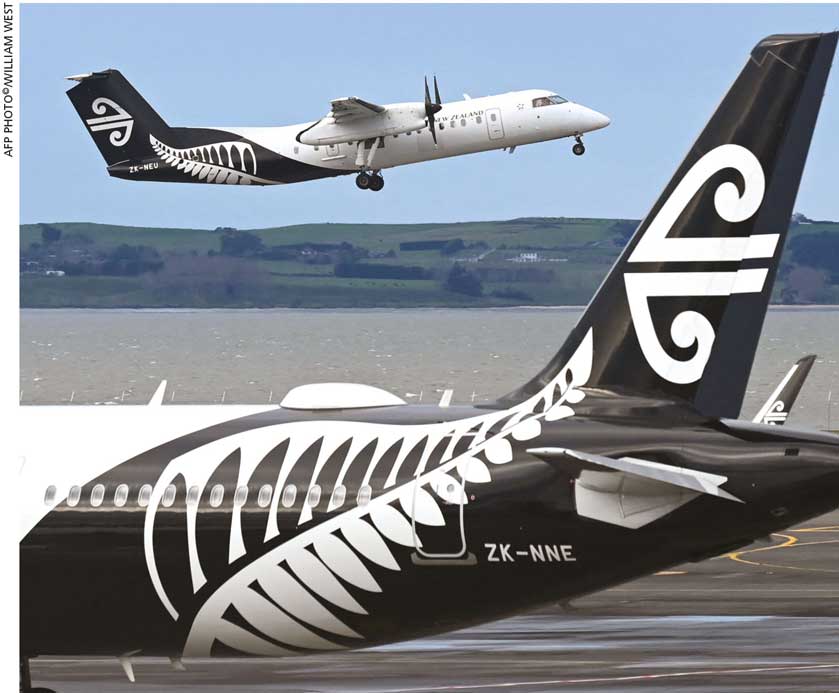AVIATION INDUSTRY

VIEWPOINT
LIFELINE TO THE WORLD
BY Priyan Rajapaksa

Air New Zealand, which is the country’s national airline, came to the nation’s rescue when vital exports had to be despatched during the pandemic. The airline commenced operations as Tasman Empire Airways in 1940, and utilised flying boats between Auckland and Sydney.
Similar to many international airlines, this carrier has had many ups and downs, and became wholly owned by the government by merging with the domestic carrier to become Air New Zealand in 1989.
After a brush with bankruptcy due to a tie-up with Ansett Australia and subsequent recapitalisation, the government now owns 53 percent of the airline.
The importance of maintaining a viable national airline for a country as isolated as New Zealand is became evident when the pandemic hit it in early 2020. It follows that the government supported the airline financially.
New Zealand’s government continues to support the airline while aviation markets stabilise and the world moves towards normalised border operations. It was part of the Maintaining International Air Connectivity (MIAC) scheme; and though international passengers reduced drastically, state financing helped Air New Zealand add airfreight capacity.
Of high value and much in demand, New Zealand products such as lamb to the UK, cherries to Asia, and capsicums to Japan and Australia need to reach those markets on time at the peak of summer.
In the midst of the downturn, Air New Zealand added Vancouver as a destination – to export chilled meat, seafood and fresh produce. The airline says there hasn’t been a single day when an international flight has taken off sans cargo.
The Crown loan facility made available to Air New Zealand in March 2020 has been extended to a debt facility of up to NZ$ 1.5 billion (an additional 600 million dollars) available until 27 September 2023 (a further 16 months). The interest rate will be adjusted to reflect current market conditions.
This debt funding agreement is provided – and was negotiated – on an arm’s length basis with each party having been independently advised. The original facility comprised two instalments – i.e. tranche A of NZ$ 600 million and tranche B of 300 million dollars.
Tranche A will be increased by NZ$ 400 million (taking it to one billion dollars) and tranche B will be bolstered by 200 million dollars (making it NZ$ 500 million).
Under a revised support package, Air New Zealand will have access to a further NZ$ 500 million (337 million dollars) in liquidity, taking the total support scheme up to NZ$ 2 billion.
New Zealand’s Minister of Finance Grant Robertson notes: “The Crown’s role as majority shareholder has been a major source of stability for the national airline during a very difficult time.”
“As a result, our national carrier is in a much stronger position than many airlines around the world. We need that strength to be retained – because we need a national airline to support economic development and provide access to international markets; and to enable the international tourism we’re beginning to see emerge with the opening of borders,” he adds.
Robertson continues: “We also need a national airline to provide a domestic network that allows people to be where they want to be across New Zealand and gets goods where they are needed.”
The loan agreement doesn’t affect the government’s operating position or net debt as it’s a commercial loan that is expected to be repaid when Air New Zealand raises capital. Fortunately, New Zealand has an honest and transparent government, which is kept that way by a free press.
Since New Zealand is four times the size of Sri Lanka, and with 25 percent of its population scattered across a large area, it has embraced air travel readily. Like Sri Lanka, the population is separated by hills at the centre of the country so travelling across it by road takes a long time.
Additionally, New Zealand is 1,600 kilometres long and driving across its length takes two to three days. So most long-distance travel is by air. Air New Zealand carried 170,000 domestic customers last year.
Sri Lanka too once had much potential. One remembers sadly the airports in Ampara, Anuradhapura and Batticaloa among other places – and weeps for our nation, and the opportunities it has squandered.
New Zealand has 62 airports, of which three are international. Air New Zealand flies to 20 of the larger airports and small private carriers serve the smaller aerodromes. The airline uses a mix of 103 jet and turboprop aircraft with seven Boeing 777-300 planes in storage due to the pandemic.
Even though Air New Zealand has 100 aircraft, none of these have provision for being fitted with luxury VIP cabins. Luckily, New Zealand purchases aircraft based on utility value and not kickbacks and commissions – so the fleet is ideal for its role.
And to combat human predators, Air New Zealand has a policy of not seating adult male passengers next to unaccompanied children due to an incident that took place in 2004.





Leave a comment